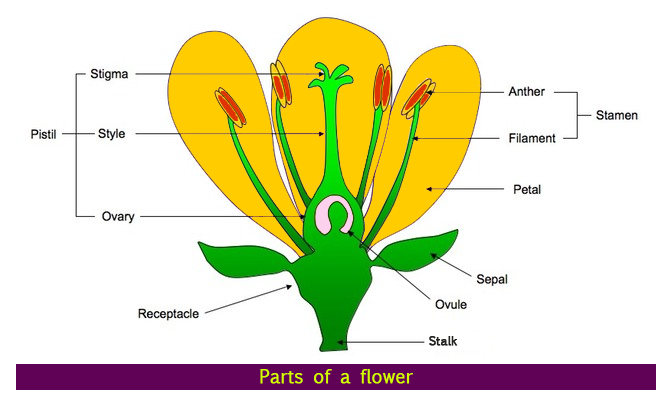
Give examples of Gamosepalous, Polysepalous, Gamopetalous and Polypetalous based on Calyx and Corolla respectively.
Answer
395.1k+ views
Hint: Calyx and Corolla are the important floral whorls of the flower. The Calyx is the utmost whorl which comprises green fused or separate sepals. The Corolla is the second important whorl which is the petals. The Calyx and the Corolla are the non-reproductive parts of the flower.
Complete answer:
The angiosperm plants contain flowers. The group of sepals are known as Calyx. They are mostly green in colour. The main function of the Calyx is to protect the flower bud and also to hold the petals. It does not play any role in reproduction.
Parts of the flower are shown in the figure below:

The sepals are of two types based on the arrangement-
i) Gamosepalous: The flowers which have fused sepals are known as gamosepalous.
Examples: Hibiscus or China rose.
ii) Polysepalous: The flowers in which the sepals are free.
Example: Rose.
The group of petals are known as the Corolla. The function of the petals is to protect the reproductive whorls or the flower. The petals are mostly coloured and attractive so that they can attract the pollinators like bees for bringing about pollination.
Based on the arrangement the petals are of two types-
i) Gamopetalous: The flowers in which the petals are fused or united are known as gamopetalous flowers.
Example: Elderberry.
ii) Polypetalous: The flowers in which the petals are free.
Example: Rose.
Note: The arrangement of sepals and petals are the characteristic identifying feature of a particular family. The other two important reproductive whorls of flower are androecium( male reproductive) which comprises stamens and the female reproductive gynoecium which comprises stigma, style and ovary.
Complete answer:
The angiosperm plants contain flowers. The group of sepals are known as Calyx. They are mostly green in colour. The main function of the Calyx is to protect the flower bud and also to hold the petals. It does not play any role in reproduction.
Parts of the flower are shown in the figure below:

The sepals are of two types based on the arrangement-
i) Gamosepalous: The flowers which have fused sepals are known as gamosepalous.
Examples: Hibiscus or China rose.
ii) Polysepalous: The flowers in which the sepals are free.
Example: Rose.
The group of petals are known as the Corolla. The function of the petals is to protect the reproductive whorls or the flower. The petals are mostly coloured and attractive so that they can attract the pollinators like bees for bringing about pollination.
Based on the arrangement the petals are of two types-
i) Gamopetalous: The flowers in which the petals are fused or united are known as gamopetalous flowers.
Example: Elderberry.
ii) Polypetalous: The flowers in which the petals are free.
Example: Rose.
Note: The arrangement of sepals and petals are the characteristic identifying feature of a particular family. The other two important reproductive whorls of flower are androecium( male reproductive) which comprises stamens and the female reproductive gynoecium which comprises stigma, style and ovary.
Recently Updated Pages
The correct geometry and hybridization for XeF4 are class 11 chemistry CBSE

Water softening by Clarks process uses ACalcium bicarbonate class 11 chemistry CBSE

With reference to graphite and diamond which of the class 11 chemistry CBSE

A certain household has consumed 250 units of energy class 11 physics CBSE

The lightest metal known is A beryllium B lithium C class 11 chemistry CBSE

What is the formula mass of the iodine molecule class 11 chemistry CBSE

Trending doubts
Is Cellular respiration an Oxidation or Reduction class 11 chemistry CBSE

In electron dot structure the valence shell electrons class 11 chemistry CBSE

What is the Pitti Island famous for ABird Sanctuary class 11 social science CBSE

State the laws of reflection of light

One Metric ton is equal to kg A 10000 B 1000 C 100 class 11 physics CBSE

Difference Between Prokaryotic Cells and Eukaryotic Cells




